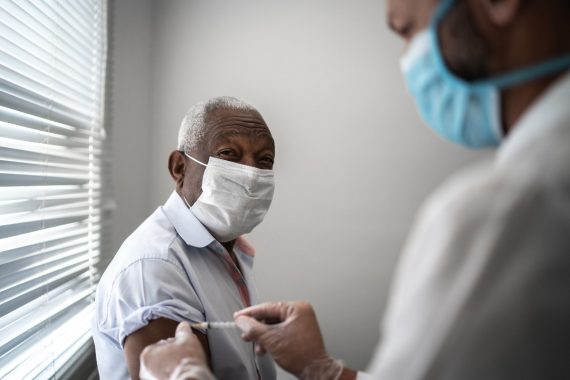White people are three times as likely to have had a Covid-19 vaccination compared those of mixed race, and twice as likely compared to black people, RCGP analysis of official data has shown.
According to the figures, which cover England only, white people were also 1.5 times more likely to have been vaccinated than Asian people.
The RCGP said it is concerned that many ‘vaccine hesitant’ patients may belong to the communities worst hit by the virus.
It has now called for a high-profile national campaign – involving faith leaders and public figures from black, Asian and ethnic minority (BAME) communities – to tackle myths about the vaccine and promote uptake.
Reports have shown that vaccine hesitancy within BAME communities may be down to several factors, including historic trust issues stemming from personal and collective experiences, the RCGP said.
As of 2 February, 14.4% of all white people in England were vaccinated (7.02 million), while the same was true of 4.7% of mixed race people (62,000), 9.2% of Asian people (411,000) and 6.8% of black people (135,000), according to the RCGP.
The RCGP said it has already written to health secretary Matt Hancock on the need to improve vaccine uptake among BAME communities, and welcomed recently launched schemes, such as the appointment of community champions, but urged that more needs to be done.
Professor Martin Marshall, RCGP chair, said: ‘Ensuring that all our patients, particularly those who are considered high-risk, receive the vaccine when offered it must be addressed urgently.
‘Society is changing, but we know that historic issues within healthcare and the wider society have, understandably, left some communities with mistrust and concerns.’
He said the ‘best way to address these concerns is to ensure that they are heard and provide as much information and clarity as possible’ but warned that the information ‘has the potential to be ignored if messages aren’t delivered by people who BAME communities can relate to and have confidence in’.
He added: ‘As GPs, we can provide the scientific evidence and reassurances that these vaccines have been rigorously tested and that they work.
‘However, faith leaders and popular public figures from BAME backgrounds know their communities and have shared experiences. They often have huge influence and are the very heart of the communities to which they belong, and this could be invaluable in helping to deliver reassuring messages.’
The news comes as NHS England has tasked its primary care director Dr Nikki Kanai with heading up a team focused on boosting Covid vaccination among BAME NHS staff.
Last month, the Government’s Covid vaccination plan revealed that GP-led roving vaccination teams ‘could be extended’ to reach minority groups such as the homeless and ‘communities with lower vaccination rates’.


















READERS' COMMENTS [1]
Please note, only GPs are permitted to add comments to articles
Prof Marshall is not being totally honest: – the vaccines have not been ‘rigorously tested’ with the usual / normal length of time taken for clinical trials – nor necessarily shown to ‘work’.
A critical review of the clinical ‘phase 3’ trials presents many questions – the reported percentage ‘efficacies’ (which properly should be ‘effectiveness’) are quoted in a way to suggest a vaccination will provide upto, e.g. In Pfizer trial, 95% protection.
This is not the reality. The 95% is the difference, in SARS-2 infected participants, between the vaccinated to the unvaccinated cohorts.
Again in Pfizer, this was 8 versus 162 cases respectively. As 8 is 5% of 162, the claim is that this translates to a 95% protection – however, there were 21,700 trial participants in each cohort.
It could be stated that in the unvaccinated group, 21,538 did not become infected, presumably with the same risk of exposure.
Most people would interpret the 95% to mean that they had reduced their risk of infection to 5%.
Additionally, in all 3 trials (Pfizer, Moderna, Astra-Zeneca), the quote in each is ‘mortality similar’ between vaccinated and unvaccinated.